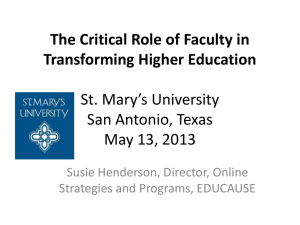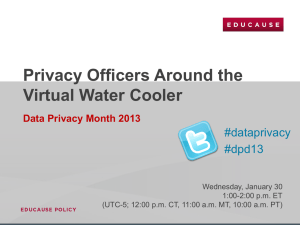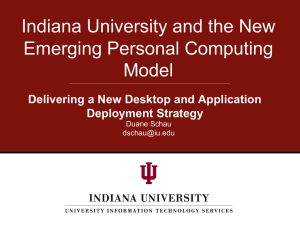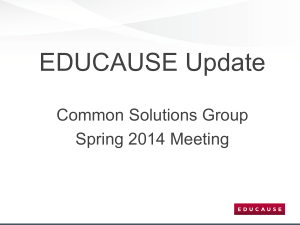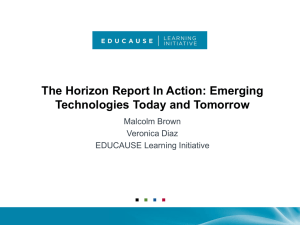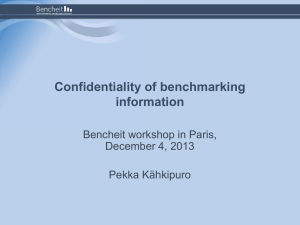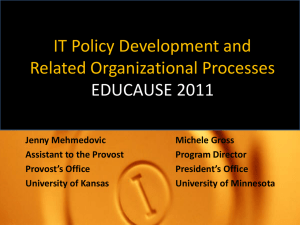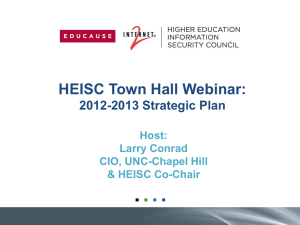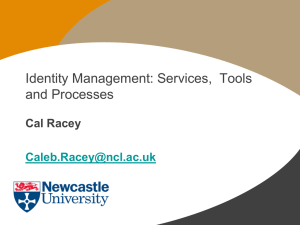Authentication
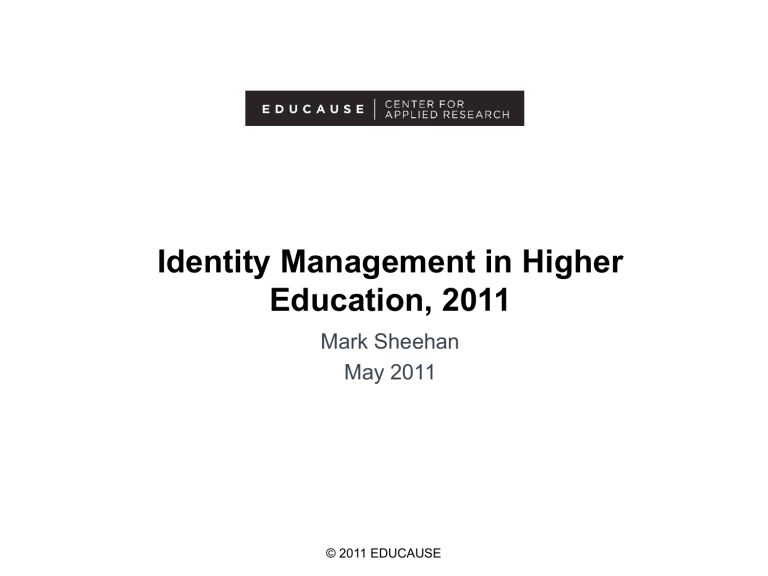
Identity Management in Higher
Education, 2011
Mark Sheehan
May 2011
© 2011 EDUCAUSE
EDUCAUSE 2011 STUDY OF IDENTITY MANAGEMENT
Contents
Survey Respondents
Motivators and Challenges for ID Management initiatives
Benefits of ID Management
Initiating and Funding ID Management projects
Five Core Elements of ID Management
Key Outcomes
Source: Sheehan, Mark C. and Cedric Bennett, with Pam Arroway, Susan Grajek, Judith A.
Pirani, and Ronald Yanosky, Identity Management In Higher Education, 2011 (Research Study,
Vol. 1). Boulder, CO: EDUCAUSE Center For Applied Research, 2011. Available from http://www.educause.edu/ecar .
© 2011 EDUCAUSE 2
SURVEY RESPONDENTS
© 2011 EDUCAUSE 3
2010 Survey Responses
1,726 invitations
323 respondents
18.7% response rate
Doctorals overrepresented
Associate’s institutions most underrepresented
Reprises 2005 study
403 respondents in 2005
137 responded to both surveys
© 2011 EDUCAUSE 4
MOTIVATORS AND CHALLENGES FOR ID
MANAGEMENT INITIATIVES
© 2011 EDUCAUSE 5
MOTIVATORS FOR
PURSUIT OF IDENTITY
MANAGEMENT
Security and privacy remain the primary motivator for IdM.
Positioning the institution for federated identity was selected
1.7 times as often in 2010 as in
2005; no other motivator varied significantly by year.
Doctoral and liberal arts (BA) institutions were each twice as likely as others to select cost reduction/ increased efficiency as a top motivator and one-third as likely to select keeping current with accepted IT directions.
© 2011 EDUCAUSE 6
CHALLENGES TO
PURSUIT OF IDENTITY
MANAGEMENT
Most of the top challenges are organizational rather than technical.
Difficulty developing campus policies and procedures was selected half as often in 2010 as in 2005.
Two technical challenges were selected half as often in 2010 as in 2005: immaturity of technical solutions and problems with vendor software and support.
The rain falls equally on all parades: challenges did not vary meaningfully by Carnegie class or institution size or control.
© 2011 EDUCAUSE 7
BENEFITS OF ID MANAGEMENT
© 2011 EDUCAUSE 8
IDENTITY
MANAGEMENT
BENEFITS
Mean importance of benefits exceeded mean capability by
0.3 to 0.9 points.
Performance is improving: in the longitudinal sample, mean “capability gap” between importance and capability was 1.0 points in
2005 and only 0.6 points in
2010.
Capability scores were averaged for each institution to yield a composite
“capability score,” one of this study’s primary measures of
IdM success.
© 2011 EDUCAUSE
*Scale: 1=very low, 2=low, 3=medium, 4=high, 5=very high
9
Capability median
3.27
IDM BENEFIT CAPABILITY, BY BENEFIT IMPORTANCE
Importance median
3.95
*Scale: 1 = very low, 2 = low, 3 = medium, 4 = high, 5 = very high
© 2011 EDUCAUSE 10
INITIATING AND FUNDING ID MANAGEMENT PROJECTS
© 2011 EDUCAUSE 11
RESOURCES FOR IDM TRACK WITH SENIOR MANAGEMENT
UNDERSTANDING
*Scale: 1=strongly disagree, 2=disagree, 3=neutral, 4=agree, 5=strongly agree
In both years, where senior management understood IdM costs and benefits, mean agreement about resource provision was at least a full point higher.
Those agreeing that senior management understood the benefits of IdM increased by
43% from 2005 to 2010; those agreeing it understood the costs more than doubled.
© 2011 EDUCAUSE 12
COORDINATING IDM PROJECTS
IdM projects became more focused between 2005 and 2010.
In 2010:
They were 50% more likely to stand alone, 25% less likely to be bundled with security projects and 33% less likely to be bundled with portal projects.
They were equally likely to be funded through one-time campus budget allocations but 60% less likely to have their funding bundled into other project budgets such as an ERP.
They were about half as likely to be sponsored by IT administrators other than the CIO or chief information security officer.
© 2011 EDUCAUSE 13
FIVE CORE ELEMENTS OF ID MANAGEMENT
© 2011 EDUCAUSE 14
FIVE CORE IDENTITY MANAGEMENT ELEMENTS
Federated
Identity
© 2011 EDUCAUSE 15
FIVE CORE ELEMENTS OF IDENTITY MANAGEMENT
Authentication : Are you who you say you are? By authenticating with trusted credentials, you let networks, systems, and applications know you can be trusted.
Enterprise Directory : Does your institution have a single, authoritative repository of information about IT resources and their users? An enterprise directory will provide one.
Reduced or Single Sign-On : How many usernames and passwords must you juggle to access the IT resources you need? Reduced or single sign-on technologies can help keep that number manageable.
Automated Role- or Privilege-based Authorization : What do you need IT resources for? In complex IT environments, the process of empowering users to carry out their roles can benefit from automation.
Federated Identity : Do you need to use IT resources that another institution maintains and protects? An identity federation lets you use locally assigned credentials to gain access to remote resources.
© 2011 EDUCAUSE 16
Identity Proofing:
Relatively few institutions are engaged in these activities.
Larger numbers are not planning to become engaged in them.
Higher standards for users in sensitive roles are least common.
© 2011 EDUCAUSE 17
2010 Saw Progress In:
Use of strong passwords
Use of “unique for all time” identifiers
Prohibiting transmission of unencrypted passwords
© 2011 EDUCAUSE 18
Passwords remain the primary authentication method.
Kerberos is used by a third of respondent institutions (and by more than half of doctorals).
Strong passwords and multi-factor methods other than biometric ID are relatively often planned.
© 2011 EDUCAUSE 19
Enterprise Directory:
Fully operational implementations (FOIs) nearly doubled between 2005 and
2010.
Larger institutions more often reported FOIs.
EDs are used most for authentication and authorization and to store affiliation and group information, and less often for other functions.
© 2011 EDUCAUSE 20
Enterprise Directory Approaches
(multiple responses allowed)
A network operating system approach was in the top three for all
Carnegie classes (<50% only for doctorals).
Doctoral institutions (40%) were more likely than any other Carnegie class (9%-33%) to approach ED as a stand-alone system using commercial vendor software .
Stand-alone, open-source ED systems were in the top three approaches selected by doctoral (33%), BA-liberal arts (29%), and other bachelor’s (9%) institutions.
All classes but doctorals and BA-liberal arts institutions often (>20%) selected “part of vendor-supplied application software (e.g., ERP)” as a top-three approach.
© 2011 EDUCAUSE 21
Reduced or Single Sign-On:
Half of respondents report at least partially operational implementations of RSSO,
There was no significant change in stage of implementation from 2005 to
2010.
Stage of implementation was more advanced among larger institutions and doctorals than among smaller, less complex ones.
© 2011 EDUCAUSE 22
Open-source software such as
Kerberos, CAS, or PubCookie was most frequently selected as an RSSO approach (41.4%).
Doctorals were most likely to select open-source software as an approach.
Commercial vendor (e.g., RSA,
Aladdin) and homegrown software were selected by about a quarter of respondents.
© 2011 EDUCAUSE 23
Role-Based Authentication:
Implementation activity increased from 2005 to
2010; FOIs more than doubled.
In 2010 doctoral and master’s institutions were most likely to have FOIs, followed by associate’s and then bachelor’s institutions.
Stage of implementation differed significantly but not greatly with institution size.
© 2011 EDUCAUSE 24
Where automated role-based authorization is in place, it is applied most often for broad affiliation classes.
Ability of the institution’s rolebased authentication environment to make privileging decisions based on fine-grained roles or affiliations in all cases was seven times as common at public institutions as private ones; no other ability varied by
Carnegie class, institution size or institutional control.
© 2011 EDUCAUSE 25
Federated
Identity
Federated Identity (FID)
Doctoral institutions were more than twice as likely as other Carnegie classes to have fully operational FID solutions in place and were much more likely to have implementations underway.
53% of respondents agreed or strongly agreed that over the next 12 months, demand for cloud computing resources would increase need for FID services.
© 2011 EDUCAUSE 26
Federated
Identity
A small majority of respondents included reduced/single sign-on within the institution among the three they considered “primary.”
• Doctorals were the
Carnegie class least likely to include this motivator but were much more likely than others to include providing for extra-institutional research collaboration.
Relatively few included enabling access to institutional resources by external users.
© 2011 EDUCAUSE 27
KEY OUTCOMES
OUTCOME: GETTING
EXPECTED VALUE FROM
IDM PROJECTS
Most institutions agreed they were getting the value they expected from
IdM projects.
Among those that didn’t agree, the majority were neutral on the question or didn’t know the answer.
Only 8% of respondents disagreed at some level.
Mean agreement did not change significantly between 2005 and
2010.
In neither year did mean agreement did not vary significantly by Carnegie class, institution size, or institutional control.
© 2011 EDUCAUSE 29
OUTCOME: MEETING
EXPECTATIONS ABOUT
COST SAVINGS FROM
IDM PROJECTS
Nearly 1 institution in 5 didn’t know if it had achieved cost savings from its
IdM projects.
Just over 1 institution in 5 had achieved cost savings from IdM projects but many of those did not expect more.
Among those that had not achieved savings, slightly more than half did not expect to do so.
Responses did not change significantly between 2005 and 2010.
In neither year did mean agreement did not vary significantly by Carnegie class, institution size, or institutional control.
© 2011 EDUCAUSE 30
OUTCOME: IDENTITY
MANAGEMENT
CAPABILITY SCORE
To compare institutions, for each one, we calculated its mean reported capability to deliver the 14 IdM benefits; we called the result the institution’s
“capability score.”
Capability score improved significantly between 2005 and
2010.
In neither year did capability score vary significantly by Carnegie class, institution size, or institutional control.
*Scale: 1 = very low, 2 = low, 3 = medium, 4 = high, 5 = very high
© 2011 EDUCAUSE 31
READINESS AND
IDM OUTCOMES
A number of IdM readiness activities are significantly associated with IdM capability score.
Each appears to boost capability score by between
0.2 and 0.8 points on our five-point scale.
READINESS ACTIVITY
Monitoring a set of IdM-related metrics
Having IdM-related policies in place
Capability
Score
Boost*
0.8 point
0.5 point
Documenting campus data custodians/owners
Providing for recovery of identity services in disaster recovery plan
Conducting an inventory of campus identifiers
Conducting a risk assessment of data access security and privacy practices
0.5 point
0.5 point
0.4 point
0.4 point
Providing sufficient resources for IdM 0.3 point
Developing a documented plan for
IdM
0.2 point
*Scale: 1 = very low, 2 = low, 3 = medium, 4 = high, 5 = very high
